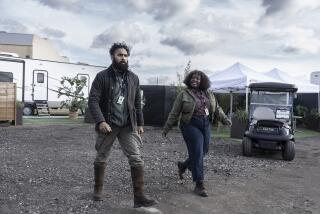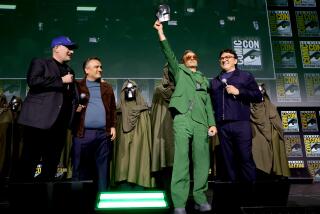How ‘The Falcon and the Winter Soldier’ demonstrates Marvel’s approach to TV
Malcolm Spellman knows what’s coming when you ask him about “The Falcon and The Winter Soldier” premiering right on the heels of the successful “WandaVision.”
“Journalists are so mean,” the show’s creator and head writer jokes before breezily waving off any concerns. “‘WandaVision’ threw up the alley oops for us and I’m hoping we’re gonna slam it home.”
Spellman’s easy confidence is understandable after watching the first episode of “The Falcon and The Winter Soldier,” which began streaming Friday on Disney+. While they share Marvel DNA, the two shows are completely different.
Set after the events of “Avengers: Endgame” (2019), “The Falcon and The Winter Soldier” follows Sam Wilson (Anthony Mackie) and Bucky Barnes (Sebastian Stan) trying to navigate a world that is adjusting to the sudden reappearance of half of the inhabitants of the universe. Both Sam and Bucky are among the populace that had been blipped out of existence five years ago and are suddenly without one of their closest friends — Captain America.
In many ways, “The Falcon and the Winter Soldier” is more straightforward than “WandaVision.” But the premiere suggests it will take on injustice.
Unlike “WandaVision,” whose experimental format saw its main characters inhabit various decades of television, “The Falcon and The Winter Soldier” is more a traditional action-oriented story set firmly in modern times. Among the themes the six-episode series will tackle are Captain America’s legacy and what it means to be a hero in the world, and in this country, today.
“We knew that we wanted these heroes to feel extremely relevant when this was done,” says Spellman, whose previous credits include “Empire” and “Hip Hop Uncovered.” “We wanted them to feel like they were of the times, meaning the heroes that step out of this series should feel like they’re the right people for the next 10 to 20 years.”
The series picks up after Sam, a.k.a. the Falcon, has inherited Captain America’s shield after Steve Rogers chose to retire from the superhero life by traveling back in time. The implication is that the mantle is also Sam’s to carry on.
“Sam has had to process what that symbol means when it’s in his hands,” says Spellman. “Because it’s a very different symbol in his hand than when it’s in Steve’s hands. And he’s decided it doesn’t work. It’s not appropriate. ‘As a Black man, I cannot carry this burden.’ [But] at the same time, he’s thinking, ‘Why would Steve Rogers have given me [the shield] if I wasn’t ready or right for it?’ And he’s got to deal with all of that.”
And a story about whether a Black man does or doesn’t take on the Captain America mantle, as Spellman says, is “one of the most relevant, if not the most relevant, superhero stories that you can tell when you factor in the world we’re in today.”
Bucky, on the other hand, is trying to process the trauma that comes with being a former brainwashed assassin who spent decades fighting for an evil organization.
“He’s been deprogrammed and he can no longer hide from all that baggage,” says Spellman. “He’s engaged with trying to confront it but he has too much guilt and too much regret to confront it the right way. His story is embodied in a real person, and we get the feeling that if he fails to make amends with this real person, he’ll never ever shake that burden off his back.”
In Marvel’s “WandaVision,” nothing is as it seems. So we prepared an episode-by-episode guide to the Disney+ series for you to keep handy as you watch.
That the series is a buddy two-hander was one of the parameters Marvel set up before Spellman was hired for the job. But he says he knew the pairing would work after seeing their short exchange inside the car in “Captain America: Civil War” (2016). Spellman explains that after Marvel creates story arenas to start the conversation around the direction of the series, it also provides a list of characters that are available to be pulled from (although, as the studio announces new projects, that list can change). The focus is on telling an organic story, which means any Easter eggs or any possible threads leading to other areas within the MCU generally come later.
On the surface, “The Falcon and The Winter Soldier’s” high-caliber action makes the series difficult to distinguish from the tentpole films the MCU is known for. And that’s the point.
“I don’t really differentiate between screens so much anymore,” says series director Kari Skogland, whose resume includes both TV and movies. “From the beginning we all said — in particular [Marvel Studios President] Kevin [Feige] — we make movies. We’re filmmakers. So that’s what we’re going to do, we’re just going to make it a big movie.”
Skogland directing all six episodes meant the shoot could be scheduled like a movie and also allowed scenes to inform one another as the characters and their dynamics were developed. And while it’s still uncommon for a sole director to helm an entire series, Skogland believes it’s “a wave of filmmaking that’s coming.”
“Whether it’s two hours, four hours, six hours, or 10 hours, it’s a bit about the stamina, you know, whether you can pull it off or not,” says Skogland.
Still, Spellman explains, “it’s a completely different kind of storytelling” between movies and TV shows.
“What Kevin wanted us to do was create a show where each individual episode feels like a movie, but it has the deep dive of a series,” Spellman says. “Movies storytelling is vertical storytelling — it’s compressed time, in general, it’s urgent, it builds toward one event. That means the character relationships and the character arcs have a rhythm to them that is specific to that flow.
“Series storytelling is horizontal and the character journeys are completely different,” Spellman continues. “You’re not just stretching it out. The rhythm is very, very different. And we worked hard to find story mechanics that felt like it was a hybrid so that each episode feels like a movie yet each episode connects to the whole in a way that is always promising what’s next.”
Spellman credits the diversity of the creative team for how timely “The Falcon and The Winter Soldier” feels.
“I think that was part of having a room that’s diverse and has LGBT and Black folk — [a room] packed with people who have struggled as not fitting into what’s mainstream,” Spellman says. “It allowed us to sort of tap into big themes and ideas and storylines that was relevant to us already.”
One thing the team could not predict was a pandemic that affected the show’s production timeline. But the series was already set as a story that is happening because of “the Blip,” which caused half the world’s inhabitants to suddenly disappear and just as suddenly reappear five years later.
“The Blip is a global problem that every single person, whether they’re a superhero, rich, poor, Black or white has to deal with,” Spellman says. “Because the pandemic shut us down, it gave us time to draw those parallels even more clearly.”
“During the Blip, of course, you had sort of this universal cooperation,” adds Skogland. “Borders changed. People were able to cooperate in a different capacity because they were sharing grief at losses that they had. Financial fortunes changed from good to bad, bad to good. Everything went into sort of a chaos, sorted itself out, and people [are] moving forward.
“And then boom, everyone comes back. The switch gets flipped again. And the suggestion is that a lot of people, by definition, are going to want to turn the clock back” to the way things used to be, Skogland says.
It is within that backdrop that Sam and Bucky have to process their feelings around Steve and Captain America’s legacy. And the show will question the relevance of the type of hero the original Captain America symbolizes in the world today. But a journey to understand everything the shield previously embodied is necessary before it can be made to embody anything else.
“I think having a Black man and African American be presented to the world as a giant heroic icon is absolutely necessary for making the world start to see us,” says Spellman. “It’s a way to make the world understand that we are all connected. We are all capable of greatness, including the people who have had the most crap thrown down on them. I just think having a Black icon like this is absolutely necessary for these times. And I’m grateful to be involved with bringing him to life.”
More to Read
The complete guide to home viewing
Get Screen Gab for everything about the TV shows and streaming movies everyone’s talking about.
You may occasionally receive promotional content from the Los Angeles Times.







